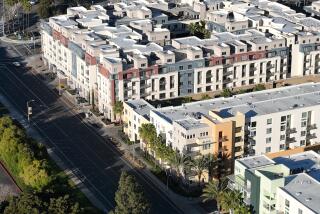Cities Face New Pressure to Provide ‘Fair Share’ of Affordable Housing
- Share via
As San Diego County cities fall farther behind in providing affordable housing for lower-income people, they face a rising specter of severe political and legal consequences.
Today, 161,000 households in the county--mainly the elderly, farm workers, single parents and the disabled--need housing assistance, up from 133,000 five years ago, according to the San Diego Assn. of Governments.
This unmet need is causing increasing friction as local government is being more forcefully challenged by an unusual alliance of developers, contractors, churches and advocacy groups for the poor.
The situation is especially tense this year because San Diego County’s cities are revising the housing portions of their general plans for the first time in five years.
Meanwhile, a bill that would take control of some housing development away from cities is advancing through the Legislature.
“I feel the noose slowly tightening around our necks,” county Supervisor Brian Bilbray said.
Uncomfortable with the heat coming from Sacramento, some cities also feel unfairly pressured by Sandag, the regional planning agency that sets the so-called “fair share” lower-income housing goals for cities to put in their general plans.
Some slower-growth cities say the demands on them to provide such housing hurt their efforts to limit all residential development, and give builders leverage to seek approval of large subdivisions that contain some lower-cost units.
“We don’t think it’s a fair and reasonable share,” said Marty Orenyak, director of community development in Carlsbad. “As a consequence, we shouldn’t have to absorb all these units.”
Orenyak agrees that cities must help create affordable housing, but believes that Sandag is asking too much from his city, which has tried in recent years to slow the pace of development.
“We’re getting punished because we weren’t building 3,000 to 4,000 units a year, and you’re (Sandag) saying now we’ve got to catch up,” Orenyak said.
Although some are more aggressive about housing the poor than others, cities in general are criticized by both developers and housing experts for not doing nearly enough.
“A lot of the arguing about the fair-share formula (is because) they don’t like the fact that they have to do something in the first place,” said Tim O’Connell, a housing specialist and assistant to San Diego Mayor Maureen O’Connor.
However, O’Connell is also skeptical of the developers calling for cities to allow affordable units in their proposed housing projects.
“The developers don’t care about poor people, because they don’t pay mortgages,” he said. “They want to be able to build. They’re in business to make money.”
Not all of the housing situation can be laid at cities’ feet.
The Reagan Administration, touting its “New Federalism,” turned over the responsibility for lower-income housing to local government throughout the United States. Over the past 10 years, the federal Department of Housing and Urban Development’s assisted-housing budget was reduced by about 80%.
“It was a massive cutback in the federal commitment,” said Evan Becker, executive director of the San Diego Housing Commission.
While federal support waned, San Diego County grew--from 1.86 million people in 1980 to 2.4 million last year, a 30% jump. Despite a burst of development, especially in North County, the cost of housing is beyond the reach of many residents, not only lower-income people, but moderate-income households as well.
Five years ago, Sandag figured that 133,000 lower-income households needed immediate assistance, and a week ago it adopted the updated regional housing statement that puts the figure at 161,000.
“Even if we close down the border today, we’d still have that 161,000 needing to be dealt with,” said Mike McLaughlin, a Sandag senior regional planner.
Meanwhile, Sandag expects that 12,500 more lower-income households will require housing assistance over the next five years.
Confronted by such vast need, few people are satisfied with the performance of most cities or the county in solving the problem, either by approving construction of affordable housing or providing it through other means, such as securing rent subsidies for lower-income households.
Sandag’s “fair share” gives each city and the county a portion of the total lower-income housing need to fill. It asks each to meet 12.5% of the overall need every five years. Over the past five-year period, however, only 8% to 9% was attained.
Not everybody agrees that “fair share” housing goals are even realistic. Oceanside Mayor Larry Bagley called it “a nice theoretical exercise we have been going through for years.”
Cities are increasingly fearful that their “fair share”--merely a goal now--may become a mandate as pressure mounts from the Legislature, developers, housing advocates and others.
This year, all cities in San Diego County except Encinitas have started the yearlong process of updating the housing elements of their general plans. Such plans, required by state law, serve as a blueprint for a community and have sections dealing with everything from art and culture to traffic circulation and housing.
Sandag intends its “fair share” for lower-income housing to become part of these general plans.
“So many cities have done nothing but give it lip service,” said Supervisor Bilbray. “We’re going to have to get serious about it or the state’s going to take it away from us. . . . Local control will be totally lost.”
Senate Bill 2011, authored by Sen. Leroy Greene (D-Sacramento) at the behest of the California Chamber of Commerce, comes close to realizing local government’s worst fears.
The measure would prohibit cities and counties from rejecting housing projects that contain “affordable to low- and moderate-income households” unless such developments jeopardize public health or safety, encroach on agricultural land or fail to meet general plan land-use designations.
However, the bill does not require those developments to comply with other general plan provisions pertaining to such things as traffic circulation and density of housing units.
The bill, which has passed the Senate and will be heard this week by the Assembly Local Government Committee, would apply to developments with at least 20% of the total units for sale or rent to low- and moderate-income people.
Most opposition to the measure comes from local government, including the League of California Cities and the County Supervisors Assn. of California. The cities of San Diego, Carlsbad, Chula Vista and Coronado have sent letters of opposition.
The interesting, and intimidating, factor to local government is the lineup of support for the bill. Among the supporters are the California Building Industry Assn., the Associated General Contractors of California and its San Diego chapter, the California Council of Churches, the California Coalition for Rural Housing, the California Homeless Coalition and the California Rural Legal Assistance Foundation.
“I think it’s a growing alliance,” said Julie Dillon, a developer in San Diego County and president of the Building Industry Assn. of San Diego County.
“We are seeing locally now labor and minorities are understanding that restrictions in the housing supply affects them in their jobs and (finding) housing they want to live in,” she said.
Although developers have tried and failed to win legislative help on the issue, SB 2011 is given a chance to pass, especially since author Greene will offer amendments he hopes will ease opposition.
“It probably has a fairly decent chance of getting through in one form or another,” said Randy Pestor, principal consultant to the Local Government Committee.
Local government uniformly sees the bill as an unbridled attempt to take away its planning control.
In an opposition letter, Chula Vista Mayor Greg Cox cited his city’s strides in helping lower-income people get housing, even exceeding Sandag’s “fair share” goals. “The loss of home rule is too great a price to pay” for passing SB 2011, he wrote.
Similarly, Victor Pottorff of the County Supervisors Assn. of California said that “planning for housing will now be in the hands of the developers rather than local government.”
But many developers and housing activists say local government has had it coming.
Developer Dillon said that, despite growth, not enough new dwellings are being approved to meet demand. Last year, 92,000 people moved into the county, “yet the building permits dropped to about 66% of what they were three years ago,” she said.
Dillon dismisses slow-growth arguments against building enough homes, saying: “I believe we can provide for the people who want housing and maintain environmental quality. They’re not mutually exclusive.”
Although she envisions the state stepping in, Dillon--like Supervisor Bilbray--advocates regional cooperation to meet housing needs, even though it means overcoming strong community objection to specific projects.
“There will be a lot of objections and angry people in the short term,” Dillon said. “But, in the long term, you will be providing housing for the children of the people who object.”
As cities await the outcome on SB 2011, an even more formidable challenge may loom as housing advocates show a willingness to take cities to court over the adequacy of their general plan provisions for lower-income housing.
“The stick that motivates jurisdictions is litigation,” said Sandag’s McLaughlin.
Last year, California Rural Legal Assistance sued Encinitas on behalf of six migrant workers, claiming the city’s general plan did not properly address the housing needs of the poor.
Claudia Smith, the group’s local attorney, said Encinitas “was going out of its way to depopulate itself of day laborers.” The city eventually rewrote the housing element of its general plan.
(All cities in San Diego County except Encinitas are reviewing their general plans’ housing elements, as they do every five years. Encinitas prepared its housing element earlier because it became an incorporated city after the last review period was completed.)
Now Smith is looking over the cities’ shoulders as they begin their housing review. She has already written to the county, San Diego, Carlsbad, Vista, Escondido and Poway, prodding them to act on low- and moderate-income goals.
“I hope everybody sat up and took notice that we sued Encinitas,” Smith said. As to whether there will be more litigation, she said, “I’m going to wait and see what these new housing elements show.”
For all of the criticism and finger-pointing, there is also skepticism about whether local government, even under the most ideal conditions, could do enough to provide housing for the poor.
Becker of the San Diego Housing Commission said that, even if the county and cities waived developer fees, removed limits on growth and more, local governments would not have the resources to solve a significant part of the problem. Still, he encourages them to try.
Becker believes that developers are without economic incentive to provide more than a nominal number of affordable units. “There isn’t any natural motivation to serve that segment,” he said.
Becker said that nothing short of a major new involvement by the federal government will build enough units, rehabilitate housing and offer broad subsidy programs.
“You won’t get it done locally. It will take a bigger investment at the federal level,” he said.
More to Read
Sign up for Essential California
The most important California stories and recommendations in your inbox every morning.
You may occasionally receive promotional content from the Los Angeles Times.






